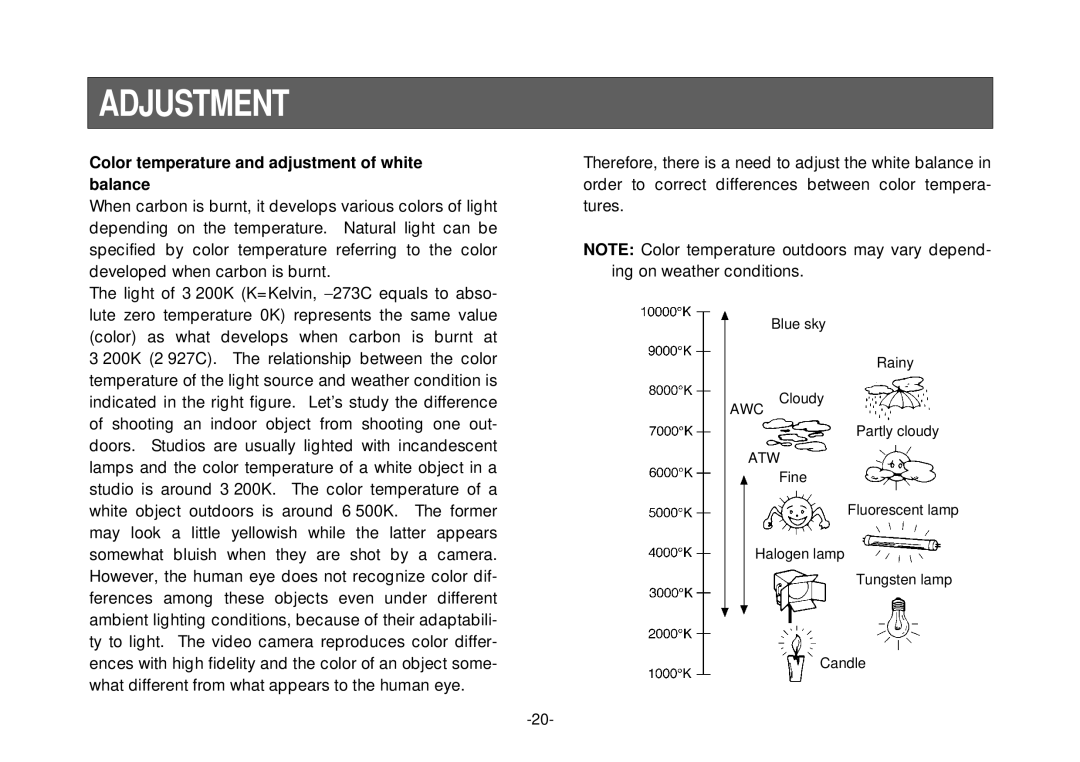Convertible Camera Model No. AW-E800
Lightning flash with arrowhead sym
Contents
Features
Preface
Special Notes on Operation
Precautions
Donts
DOS
Major Operating Controls and Their Functions
Lens fixing ring knob
Menu Switch MENU/M
ITEM/AWC Switch ITEM/AWC
Cooling Fan
Video Output Connector Video OUT
YES/ABC Switch YES/ABC/+
NO/BAR Switch NO/BAR/−
Iris Connector Iris
DC 12 V Input Connector DC 12V
11. I/F Remote Connector I/F Remote
Power Indicator
15. G/L Input Connector G/L
Mounting
Lens Mounting
Camera Mounting
Flange Back Adjustment for Zoom Lens
Automatic iris power zoom lens
Iris Gain Control in a Lens
Connection of Device with a Composite Input Connector
Connections
Connection of a Remote Control Unit RCU
WV-RC700A
Connection of a Remote Control BOX RCB
Connection of Devices with Camera PAN/TILT Control System
Lens
Connection with Multiple Cameras Color Lock Mode
Signal BB
Connection of Computer
Adjustment
Color temperature and adjustment of white balance
Automatic White Balance Control AWC
Camera
Manual White Balance Setting
Automatic Tracking White Balance Setting ATW
Reset to 3 200K or 5 600K White Balance
Black Balance Adjustment
Total Pedestal Level ADJUST- Ment
GEN-LOCK Adjustment
Horizontal Phase Control
Color Phase Adjustment
USE Mode Setting
Setting by Camera
Setting by RCU RCB or Hybrid Control Panel
Camera RCU RCB
Main Menu of User Mode
Menu Item Setting
Menu Item Setting
Main Menu Screen
From the camera alone
Setting
From RCU RCB
SUB Menu Halogen Mode, Fluorescent Mode, Outdoor Mode
Detecting Ratio Adjustment Light PEAK/AVG P50 A50
Video Level Adjustment Picture Level -50 +50
Auto ND ELC Setting Auto ND ELC ON/OFF
Manual Gain Up Control Setting Manu Gain Up DB 30 dB / N/Eye
Chroma Level Adjustment Chroma Level -3 +3
Black Level Setting Pedestal -30 +30
Contrast Adjustment Contrast Gamma LOW/MID/HIGH
0Skin Color Adjustment Flesh Tone -3 +3
6Color Bar Setup Setting Color Bar Set 0.0 IRE/7.5 IRE
4Sub Carrier Phase Coarse Adjustment SC Coarse 1/2/3/4
5Subcarrier Phase Fine Adjustment SC Fine -511 +511
7Detail Select Setting DTL Select Normal/Super
Page
@3CCD Read Out Mode Setting V Resolution Normal/Fine
@5Negative/Positive Selection Nega/Posi Posi/Nega
Sub Menu User Mode
@9Detecting Ratio Adjustment Light PEAK/AVG P50 A50
@8Video Level Adjustment Picture Level -50 +50
#1Auto Iris Level Fine Adjustment Auto Iris Adjust ON/OFF
#3Electronic Shutter Step Setting Step OFF/1/100 1/10
100, 1/250, 1/500, 1/1 000, 1/2 000, 1/4
#5CCD Read Out Mode Setting Field/Frame Field/Frame 1/Frame
#6Gain Up Setting Gain AGC HIGH/AGC LOW/ 0 dB 30 dB / N/Eye
$0Highlight Chroma Setting Highlight Chroma
#7Black Level Setting Pedestal -30 +30
#8Chroma Level Adjustment Chroma Level -3 +3
Pedestal, B Pedestal
$4Subcarrier Phase Coarse Adjustment SC Coarse 1/2/3/4
$22-dimensional Lowpass Filter Setting 2D LPF
$3Horizontal Phase Adjustment H Phase -206 +49
$5Subcarrier Phase Fine Adjustment SC Fine -511 +511
3Chroma Detail Compensation Level Setting Chroma Detail 0
0Noise Suppress Compensation Level Setting Noise Suppress 1
2Dark Detail Compensation Level Setting Dark Detail 0
5Corner Detail Setting Corner Detail OFF/ON
0White Clip Level Setting White Clip 95% 110%
8Gamma Correction Level Setting Gamma 0.35
9Knee Compensation Level Setting Knee Point 88% 98%/Dynamic
1Flare Correction Level Setting Flare R/G/B 0
Setting to Initial SET
Setting to initial set
Initial Settings of the Setting Items Factory preset values
User Mode
Appearance
Wide
Specifications
Ntsc
Back Panel MENU, ITEM/AWC, YES/ABC, NO/BAR
Standard Accessories
Optional Accessories
NM1199-1010 7J1A402B

